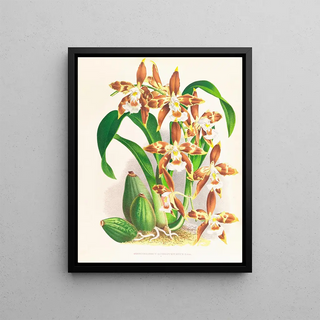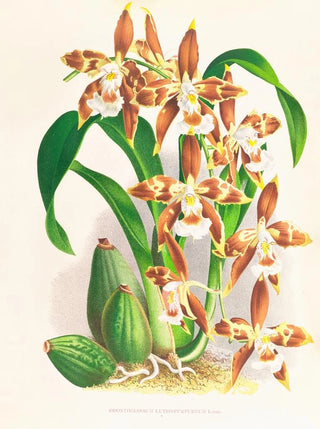Art print | Odontoglossum luteopurpureum - Jean Jules Linden


View from behind

Frame (optional)
Odontoglossum luteopurpureum - Jean Jules Linden – Captivating introduction
In the fascinating world of botanical art, the work "Odontoglossum luteopurpureum" by Jean Jules Linden stands out for its delicacy and precision. This art print, imbued with the magic of nature, transports us to a universe where every detail is celebrated with almost photographic meticulousness. The beauty of this orchid, with its vibrant shades of yellow and purple, evokes a harmony between art and nature, inviting the viewer to contemplate the splendor of forms and colors. The piece does not merely depict a flower; it tells a story, that of a passion for botany and a keen eye for the ephemeral beauty of flora.
Style and uniqueness of the work
Linden's work is characterized by a realistic style that transcends simple representation. Each petal of the Odontoglossum luteopurpureum is meticulously detailed, revealing subtle nuances of light and shadow. The colors, both vivid and delicate, seem to vibrate on the canvas, creating a sensation of movement and life. Linden managed to capture not only the appearance of the plant but also its essence, its almost living character. This striking realism is the result of rigorous observation and mastered technique, making this art print an emblematic example of 19th-century botanical art. The composition, balanced and harmonious, immediately draws the eye and invites prolonged contemplation.
The artist and his influence
Jean Jules Linden, botanist and artist, left an indelible mark in the field of floral art. Born in Belgium, he dedicated his life to the study and representation of plants, traveling around the world to collect specimens and immortalize them on canvas. Linden played a crucial role in popularizing orchids in Europe, and his work has inspired many artists and botanists. His ability to combine science and aesthetics allowed him to create works that are both scientific documents and pieces of art. Linden's influence is still felt today, both in the art world and in botany, where his

Matte finish

View from behind

Frame (optional)
Odontoglossum luteopurpureum - Jean Jules Linden – Captivating introduction
In the fascinating world of botanical art, the work "Odontoglossum luteopurpureum" by Jean Jules Linden stands out for its delicacy and precision. This art print, imbued with the magic of nature, transports us to a universe where every detail is celebrated with almost photographic meticulousness. The beauty of this orchid, with its vibrant shades of yellow and purple, evokes a harmony between art and nature, inviting the viewer to contemplate the splendor of forms and colors. The piece does not merely depict a flower; it tells a story, that of a passion for botany and a keen eye for the ephemeral beauty of flora.
Style and uniqueness of the work
Linden's work is characterized by a realistic style that transcends simple representation. Each petal of the Odontoglossum luteopurpureum is meticulously detailed, revealing subtle nuances of light and shadow. The colors, both vivid and delicate, seem to vibrate on the canvas, creating a sensation of movement and life. Linden managed to capture not only the appearance of the plant but also its essence, its almost living character. This striking realism is the result of rigorous observation and mastered technique, making this art print an emblematic example of 19th-century botanical art. The composition, balanced and harmonious, immediately draws the eye and invites prolonged contemplation.
The artist and his influence
Jean Jules Linden, botanist and artist, left an indelible mark in the field of floral art. Born in Belgium, he dedicated his life to the study and representation of plants, traveling around the world to collect specimens and immortalize them on canvas. Linden played a crucial role in popularizing orchids in Europe, and his work has inspired many artists and botanists. His ability to combine science and aesthetics allowed him to create works that are both scientific documents and pieces of art. Linden's influence is still felt today, both in the art world and in botany, where his






